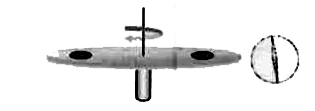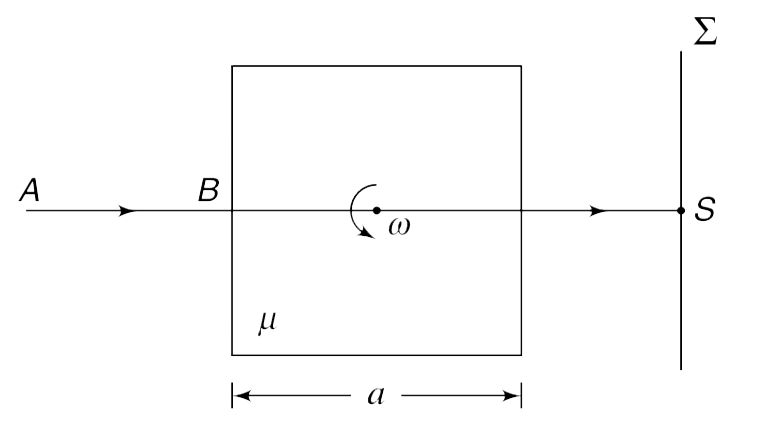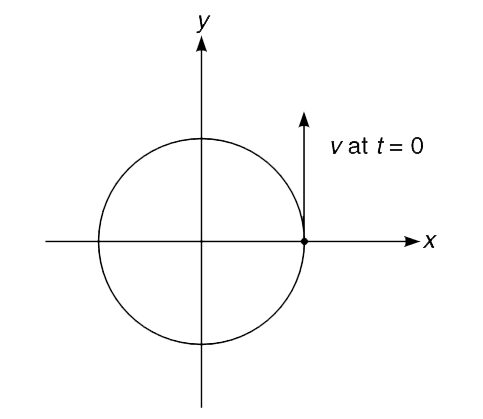Rowland (1876) placed some charges (in a fixed location) on a nonconducting disk, which he then rotated at high speed about its central axis near a delicate compass ( as shown in the following figure ). Rowland observed that :

There was no magnetic field, so nothing happened to the compass
The current created a magnetic field that deflected the compass
The charges repelled the compass by Coulomb's Law.
None of the above
The correct Answer is:B
Step by step video, text & image solution for Rowland (1876) placed some charges (in a fixed location) on a nonconducting disk, which he then rotated at high speed about its central axis near a delicate compass ( as shown in the following figure ). Rowland observed that : by Physics experts to help you in doubts & scoring excellent marks in Class 12 exams.
Topper's Solved these Questions
- BOOK - RESNICK AND HALLIDAYCHAPTER - MAGNETIC FIELDS DUE TO CURRENTSEXERCISE - Practice Question (More Than one correct choice )12videos
MAGNETIC FIELDS DUE TO CURRENTS
- BOOK - RESNICK AND HALLIDAYCHAPTER - MAGNETIC FIELDS DUE TO CURRENTSEXERCISE - Practice Question (Linked Comprehension)16videos
MAGNETIC FIELDS DUE TO CURRENTS
- BOOK - RESNICK AND HALLIDAYCHAPTER - MAGNETIC FIELDS DUE TO CURRENTSEXERCISE - Problems45videos
MAGNETIC FIELDS DUE TO CURRENTS
- BOOK - RESNICK AND HALLIDAYCHAPTER - INTERFERENCE AND DIFFRACTION EXERCISE - PRACTICE QUESTIONS (Integer Type)6videos
INTERFERENCE AND DIFFRACTION
- BOOK - RESNICK AND HALLIDAYCHAPTER - MAGNETIC FORCEEXERCISE - Practice Questions (Integer type )7videos
MAGNETIC FORCE
Similar Questions
An infinite cylinder of radius r with surface charge density σ is rotated about its central axis with angular speed ω. Then the magnetic field at any point inside the cylinder is
View SolutionA glass cube has side length a and its refractive index is μ=32 . A ray of light (AB) is incident normally on one of its face and after passing through the cube it forms a spot S on screen σ. The cube begins to rotate with angular speed ω about its central axis as shown in the Figure. Immediately after the cube begins to rotate, find the speed of the spot S on the screen.
 View Solution
View Solution
Knowledge Check
- Question 1 - Select One
A circular disc of which 2/3 part is coated with yellow and 1/3 part is with blue . It is rotated about its central axis with high velocity. Then it will be seen as
AgreenBblueCwhiteDyellow - Question 2 - Select One
A circular disc of which 2/3 part is coated with yellow and 1/3 part is with blue it is rotated about its central axis with high velocity then it will be seen as
AGreenBBrownCWhiteDViolet - Question 3 - Select One
A positive charge is fixed at the origin of coordinates. An electri dipole which is free to move and rotate is placed on the positive x-axis. Its moment is directed away from the origin. The dipole will
Amove towards the originBmove away from the originCrotate by π/2Drotate by π
A current carrying wire is placed along the axis of a uniformly charged circular ring. If the ring starts rotating about its central axis what will be force on the current carrying wire due to the moving charges of ring.
View SolutionA particle is fixed to the edge of a disk that is rotating uniformly in anticlockwise direction about its central axis. At time t=0 the particle is on the X axis at the position shown in figure and it has velocity v

(a) Draw a graph representing the variation of the x component of the velocity of the particle as a function of time.
(b) Draw the y-component of the acceleration of the particle as a function of time.View SolutionIn the figure (i) a disc of mass M(kg) and radius R(m) is rotating smoothly about a fixed vertical axis AB with angular speed 26rad/s A rod rod CD of length R2(m) and mass M(kg) is hinged at one end at point 'D' on the disc. The rod remains in vertical position and rotates along with the disc about axis AB. At some moment the rod CD gets a very smal impulse at point 'C' due to air due to which the rod falls on the disc along one radius and sticks to the disc as shown in figure (ii). Now find the angular velocity of the disc in rad/s.
 View Solution
View SolutionA rod is rotating with a constant angular velocity ω about point O (its centre) in a magnetic field B as shown. Which of the folloiwng figure correctly shows the distribution of charge inside the rod?
 View Solution
View SolutionThe general motion of a rigid body can be considered to be a combination of (i) a motion of its centre of mass about an axis, and (ii) its motion about an instantaneous exis passing through the centre of mass. These axes need not be stationary. Consider, for example, a thin uniform disc welded (rigidly fixed) horizontally at its rim to a massless, stick as shown in the figure. When the disc-stick system is rotated about the origin on a horizontal frictionless plane with angular speed ω the motion at any instant can be taken as a combination of (i) a rotation of the disc through an instantaneous vertical axis passing through its centre of mass (as is seen from the changed orientation of points P and Q). Both these motions have the same angular speed ω in this case

Now consider two similar system as shown in the figure: Case (a) the disc with its face vertical and parallel to x-z plane, Case (b) the disc with its face making an angle of 45∘ with x-y plane and its horizontal diameter parallel to x-axis. In both the cases, the disc is welded at point P, and the systems are rotated with constant angular speed ω about the z-axis.

Which of the following statements regarding the angular speed about the instantaneous axis (passing through the centre of mass) is correct?View Solution

